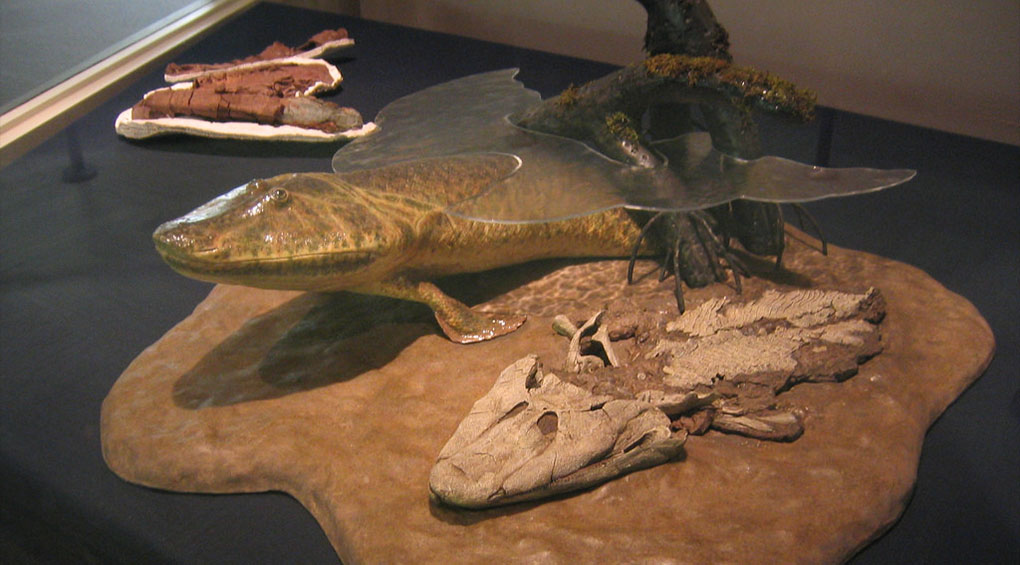and that’s why we still have fish…

Chances are that somewhere right now, a creationist is bitterly trying to prove that evolution is wrong and that the fossil record doesn’t actually provide any evidence for the theory because it won’t show how one species becomes another. Then, after either thinking that he’s triumphantly defeated modern biology or sighing heavily because those evolutionist heathens won’t heed his wise words, he leaves science writers and scientists to deal with his assertion. And here’s the funny part. Our creationist in question is absolutely right. Fossils don’t show how one species becomes another. If they did, then much of what we know about evolution would have to be drastically revised to explain how a species could suddenly change its distinguishing features. To show how biologists today explain the flow of evolution, here again is David Attenborough for the BBC’s Tree of Life.
Creationists heavily rely on the notion of separating all life into a neat, tidy box they label as kinds and we tend to label as species. The most progressive ones may even accept that within any particular species there is a level of genetic churn and outward change. But what they don’t understand, or don’t want to understand, is the nature of how we label living things. Our taxonomy is fairly arbitrary and when we really start digging down to a bone by bone analysis of the fossil record, we find a lot of overlap, and incomplete segments become hard to classify because they could belong to multiple species. That’s because in nature, species are related and as time goes on, the offspring of species A can accumulate so many genetic changes and settle in environments so inhospitable to their ancestors that they interbreed, increase the number of genetic changes they have, and eventually, their progeny could be classified as species B in a few million years or so, as the mutations keep on building with each generation even more removed from the population that gave birth to their parents.
And eventually, as their genetic changes accumulate thanks to natural selection, they’ll keep mating with each other and if they’re good enough survivors, they may even spawn species C, which will continue to repeat the cycle of speciation as long as the habitat permits it. Here’s an example of this speciation going on right now in the Arctic. Zoologists had a pretty good idea that polar bears and grizzlies were evolutionary relatives, sharing a distant ancestor which gave rise to a species well suited to hunt and forage in forests, and another that was able to live in the icy plains, hunting for seals. Normally, the two want nothing to do with each other and grizzly bears normally try to scare away any polar bear that comes too close to their territories. But today, as grizzlies are venturing further north, they’re not just bumping into polar bears for a growling contest. Instead, the bears are mating and producing huge, powerful offspring known as grolars. And should the grolars survive over a long enough period of time and start interbreeding, they’ll become a new species. Once again, nature shows how genetic mutations and natural selection shape life on our planet and how instead of one species turning into another, speciation relies on one species becoming two, and maybe even three.
So how does a creationist expect rare, often incomplete fossils to show how one species turns into another, or how that change happens when speciation requires new species branching off from established ones? If nature worked the way creationists think, Tiktaalik and well, every other fish would have to be part of one and the same species and be walking on land as amphibians, rather than just father the ancestors of amphibians which emerged out of the water and fathered the ancestors of reptiles. According to the theory of evolution, the original species can stick around for as long, or even longer then their novel descendant. That’s why there are still fish in the oceans (although not the same fish we had 400 million years ago), and modern Tiktaaliks are still appearing. According to the creationists’ quasi-Lamarckian view of evolution, that’s not how nature has to work and since they see themselves as the pinnacle of life on Earth, they’ll demand that biologists show them how a “lower form of life becomes a higher form,” a meaningless, pseudoscientific notion of those who got their idea of evolution almost solely from Rudolph Zallinger’s March of Progress.
So the next time creationist zealots devoted to disproving evolutionary science ask you to provide evidence for speciation as they believe it happens, you’ll know you’re dealing with someone who hasn’t the faintest clue of what he’s talking about, so much so that he’s arguing against potential evidence that would be a major shock to modern biologists and put some of the core concepts behind evolutionary theory into question. And if you’re the kind of creationist who likes to use this throwback to Lamarckism, you should now know that you’ve been trying to prove to people that gravity doesn’t exist by asking them why they don’t just suddenly float into space, all while telling them that floating is the highest form of locomotion according to your holy books.





